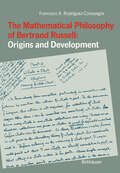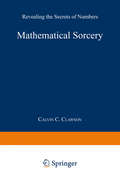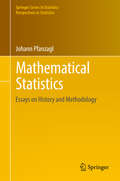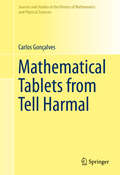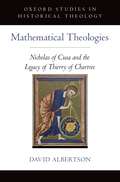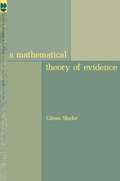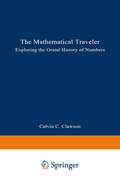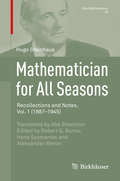- Table View
- List View
Mathematical Masterpieces: Further Chronicles by the Explorers (Undergraduate Texts in Mathematics)
by Art Knoebel Reinhard Laubenbacher Jerry Lodder David PengelleyIntended for juniors and seniors majoring in mathematics, as well as anyone pursuing independent study, this book traces the historical development of four different mathematical concepts by presenting readers with the original sources. Each chapter showcases a masterpiece of mathematical achievement, anchored to a sequence of selected primary sources. The authors examine the interplay between the discrete and continuous, with a focus on sums of powers. They then delineate the development of algorithms by Newton, Simpson and Smale. Next they explore our modern understanding of curvature, and finally they look at the properties of prime numbers. The book includes exercises, numerous photographs, and an annotated bibliography.
Mathematical Models of Perception and Cognition Volume I: A Festschrift for James T. Townsend (Scientific Psychology Series)
by Joseph W. Houpt Leslie M. BlahaIn this two volume festschrift, contributors explore the theoretical developments (Volume I) and applications (Volume II) in traditional cognitive psychology domains, and model other areas of human performance that benefit from rigorous mathematical approaches. It brings together former classmates, students and colleagues of Dr. James T. Townsend, a pioneering researcher in the field since the early 1960s, to provide a current overview of mathematical modeling in psychology. Townsend’s research critically emphasized a need for rigor in the practice of cognitive modeling, and for providing mathematical definition and structure to ill-defined psychological topics. The research captured demonstrates how the interplay of theory and application, bridged by rigorous mathematics, can move cognitive modeling forward.
Mathematical Models of Perception and Cognition Volume I: A Festschrift for James T. Townsend (Scientific Psychology Series)
by Joseph W. Houpt Leslie M. BlahaIn this two volume festschrift, contributors explore the theoretical developments (Volume I) and applications (Volume II) in traditional cognitive psychology domains, and model other areas of human performance that benefit from rigorous mathematical approaches. It brings together former classmates, students and colleagues of Dr. James T. Townsend, a pioneering researcher in the field since the early 1960s, to provide a current overview of mathematical modeling in psychology. Townsend’s research critically emphasized a need for rigor in the practice of cognitive modeling, and for providing mathematical definition and structure to ill-defined psychological topics. The research captured demonstrates how the interplay of theory and application, bridged by rigorous mathematics, can move cognitive modeling forward.
Mathematical Models of Perception and Cognition Volume II: A Festschrift for James T. Townsend (Scientific Psychology Series)
by Joseph W. Houpt Leslie M. BlahaIn this two volume festschrift, contributors explore the theoretical developments (Volume I) and applications (Volume II) in traditional cognitive psychology domains, and model other areas of human performance that benefit from rigorous mathematical approaches. It brings together former classmates, students and colleagues of Dr. James T. Townsend, a pioneering researcher in the field since the early 1960s, to provide a current overview of mathematical modeling in psychology. Townsend’s research critically emphasized a need for rigor in the practice of cognitive modeling, and for providing mathematical definition and structure to ill-defined psychological topics. The research captured demonstrates how the interplay of theory and application, bridged by rigorous mathematics, can move cognitive modeling forward.
Mathematical Models of Perception and Cognition Volume II: A Festschrift for James T. Townsend (Scientific Psychology Series #2)
by Joseph W. Houpt Leslie M. BlahaIn this two volume festschrift, contributors explore the theoretical developments (Volume I) and applications (Volume II) in traditional cognitive psychology domains, and model other areas of human performance that benefit from rigorous mathematical approaches. It brings together former classmates, students and colleagues of Dr. James T. Townsend, a pioneering researcher in the field since the early 1960s, to provide a current overview of mathematical modeling in psychology. Townsend’s research critically emphasized a need for rigor in the practice of cognitive modeling, and for providing mathematical definition and structure to ill-defined psychological topics. The research captured demonstrates how the interplay of theory and application, bridged by rigorous mathematics, can move cognitive modeling forward.
A Mathematical Odyssey: Journey from the Real to the Complex
by Steven G. Krantz Harold R. ParksMathematics is a poem. It is a lucid, sensual, precise exposition of beautiful ideas directed to specific goals. It is worthwhile to have as broad a cross-section of mankind as possible be conversant with what goes on in mathematics. Just as everyone knows that the Internet is a powerful and important tool for communication, so everyone should know that the Poincaré conjecture gives us important information about the shape of our universe. Just as every responsible citizen realizes that the mass-production automobile was pioneered by Henry Ford, so everyone should know that the P/NP problem has implications for security and data manipulation that will affect everyone.This book endeavors to tell the story of the modern impact of mathematics, of its trials and triumphs and insights, in language that can be appreciated by a broad audience. It endeavors to show what mathematics means for our lives, how it impacts all of us, and what new thoughts it should cause us to entertain. It introduces new vistas of mathematical ideas and shares the excitement of new ideas freshly minted. It discusses the significance and impact of these ideas, and gives them meaning that will travel well and cause people to reconsider their place in the universe.Mathematics is one of mankind's oldest disciplines. Along with philosophy, it has shaped the very modus of human thought. And it continues to do so. To be unaware of modern mathematics is to miss out on a large slice of life. It is to be left out of essential modern developments. We want to address this point, and do something about it. This is a book to make mathematics exciting for people of all interests and all walks of life. Mathematics is exhilarating, it is ennobling, it is uplifting, and it is fascinating. We want to show people this part of our world, and to get them to travel new paths.
The Mathematical Philosophy of Bertrand Russell: Origins and Development
by Francisco A. Rodríguez-Consuegraby Ivor Grattan-Guinness Until twenty years ago the outline history of logicism was well known. Frege had had the important ideas, until he was eclipsed by Wittgenstein. Russell was important in publicising the former and tutoring the latter, and also for working with Moore in the conversion of British philosophy from neo-Hegelianism to the new analytic tradition in the 1900s, but his own work on logic and especially logicism was very muddled. Around that time Russell, who was still alive, sold his manuscripts to McMaster University in Canada, and interest in his achievements in logic began to develop, especially after his death in 1970. Scholars found thousands of folios of unpublished holograph awaiting their attention, and also hundreds of pertinent letters (both in the Russell Archives and elsewhere in certain recipients' collections). Various facets of his work came to light for the first time, and others -which could have been gleaned from carefully reading of the published sources- gained new publicity from the evidence revealed in manuscripts. Even the technical passage work, which constitutes the unread majority of the Principia mathematica (1910-13) of Russell and Whitehead, began to receive a little respectful scrutiny. It turned out that Russell had done several pioneering things. While indeed often incoherent in reference and content, they comprised major forays into the new mathematical logic, of which he turned out to be a major founder: some are even of interest to modem studies.
Mathematical Practitioners and the Transformation of Natural Knowledge in Early Modern Europe (Studies in History and Philosophy of Science #45)
by Lesley B. Cormack Steven A. Walton John A. SchusterThis book argues that we can only understand transformations of nature studies in the Scientific Revolution if we take seriously the interaction between practitioners (those who know by doing) and scholars (those who know by thinking). These are not in opposition, however. Theory and practice are end points on a continuum, with some participants interested only in the practical, others only in the theoretical, and most in the murky intellectual and material world in between. It is this borderland where influence, appropriation, and collaboration have the potential to lead to new methods, new subjects of enquiry, and new social structures of natural philosophy and science.The case for connection between theory and practice can be most persuasively drawn in the area of mathematics, which is the focus of this book. Practical mathematics was a growing field in early modern Europe and these essays are organised into three parts which contribute to the debate about the role of mathematical practice in the Scientific Revolution. First, they demonstrate the variability of the identity of practical mathematicians, and of the practices involved in their activities in early modern Europe. Second, readers are invited to consider what practical mathematics looked like and that although practical mathematical knowledge was transmitted and circulated in a wide variety of ways, participants were able to recognize them all as practical mathematics. Third, the authors show how differences and nuances in practical mathematics typically depended on the different contexts in which it was practiced: social, cultural, political, and economic particularities matter. Historians of science, especially those interested in the Scientific Revolution period and the history of mathematics will find this book and its ground-breaking approach of particular interest.
Mathematical Problems: An Essay on Their Nature and Importance
by Craig SmoryńskiThe life and soul of any science are its problems. This is particularly true of mathematics, which, not referring to any physical reality, consists only of its problems, their solutions, and, most excitingly, the challenges they pose. Mathematical problems come in many flavours, from simple puzzles to major open problems. The problems stimulate, the stories of their successful solutions inspire, and their applications are wide.The literature abounds with books dedicated to mathematical problems — collections of problems, hints on how to solve them, and even histories of the paths to the solutions of some famous ones. The present book, aimed at the proverbial “bright high-school student”, takes a different, more philosophical approach, first dividing mathematical problems into three broad classes — puzzles, exercises, and open problems — and discussing their various roles in one’s mathematical education. Various chapters are devoted to discussing examples of each type of problem, along with their solutions and some of the developments arising from them. For the truly dedicated reader, more involved material is offered in an appendix.Mathematics does not exist in a vacuum, whence the author peppers the material with frequent extra-mathematical cultural references. The mathematics itself is elementary, for the most part pre-calculus. The few references to the calculus use the integral notation which the reader need not truly be familiar with, opting to read the integral sign as strange notation for area or as operationally defined by the appropriate buttons on his or her graphing calculator. Nothing further is required.Advance praise for Mathematical Problems "There are many books on mathematical problems, but Smoryński’s compelling book offers something unique. Firstly, it includes a fruitful classification and analysis of the nature of mathematical problems. Secondly, and perhaps most importantly, it leads the reader from clear and often amusing accounts of traditional problems to the serious mathematics that grew out of some of them." - John Baldwin, University of Illinois at Chicago"Smoryński manages to discuss the famous puzzles from the past and the new items in various modern theories with the same elegance and personality. He presents and solves puzzles and traditional topics with a laudable sense of humor. Readers of all ages and training will find the book a rich treasure chest." - Dirk van Dalen, Universiteit Utrecht
Mathematical Recreations from the Tournament of the Towns (AK Peters/CRC Recreational Mathematics Series)
by Andy Liu Peter TaylorMathematical Recreations from the Tournament of the Towns contains the complete list of problems and solutions to the International Mathematics Tournament of the Towns from Fall 2007 to Spring 2021.The primary audience for this book is the army of recreational mathematicians united under the banner of Martin Gardner. It should also have great value to students preparing for mathematics competitions and trainers of such students. This book also provides an entry point for students in upper elementary schools. Features Huge recreational value to mathematics enthusiasts Accessible to upper-level high school students Problems classified by topics such as two-player games, weighing problems, mathematical tasks etc.
Mathematical Recreations from the Tournament of the Towns (AK Peters/CRC Recreational Mathematics Series)
by Andy Liu Peter TaylorMathematical Recreations from the Tournament of the Towns contains the complete list of problems and solutions to the International Mathematics Tournament of the Towns from Fall 2007 to Spring 2021.The primary audience for this book is the army of recreational mathematicians united under the banner of Martin Gardner. It should also have great value to students preparing for mathematics competitions and trainers of such students. This book also provides an entry point for students in upper elementary schools. Features Huge recreational value to mathematics enthusiasts Accessible to upper-level high school students Problems classified by topics such as two-player games, weighing problems, mathematical tasks etc.
The Mathematical Representation of Physical Reality (The Frontiers Collection)
by Shahen HacyanThis book deals with the rise of mathematics in physical sciences, beginning with Galileo and Newton and extending to the present day. The book is divided into two parts. The first part gives a brief history of how mathematics was introduced into physics—despite its "unreasonable effectiveness" as famously pointed out by a distinguished physicist—and the criticisms it received from earlier thinkers. The second part takes a more philosophical approach and is intended to shed some light on that mysterious effectiveness. For this purpose, the author reviews the debate between classical philosophers on the existence of innate ideas that allow us to understand the world and also the philosophically based arguments for and against the use of mathematics in physical sciences. In this context, Schopenhauer’s conceptions of causality and matter are very pertinent, and their validity is revisited in light of modern physics. The final question addressed is whether the effectiveness of mathematics can be explained by its “existence” in an independent platonic realm, as Gödel believed.The book aims at readers interested in the history and philosophy of physics. It is accessible to those with only a very basic (not professional) knowledge of physics.
Mathematical Sorcery: Revealing the Secrets of Numbers
by Calvin C. ClawsonThere are two kinds of people: those who can do mathematics, and then there's the rest of us.Math is boring.Females have no facility for mathematics (and really don't need it, anyway).For many people who do not like math, these myths ring true.Calvin Clawson, the celebrated author ofMathematical Mysteries, has a unique talent for opening the door for the uninitiated to the splendors of mathematics. A writer in love with his subject, Clawson offers readers the perfect antidote to the phobias and misconceptions surrounding mathematics inMATHEMATICAL SORCERY. Contending that the power and beauty of mathematics are gifts in which we all can partake, he shows that the field of mathematics holds a bounty of wonder that can be reaped by any one of us in the hopes of discovering new truths.In this captivating quest for pure knowledge, Clawson takes us on a journey to the amazing discoveries of our ancient ancestors. He divulges the wisdom of the Ancient Greeks, Sumerians, Babylonians, and Egyptians, whose stunning revelations still have deep meaning to us today. The secrets of the constellations, the enigma of the golden mean, and the brilliance of a proof are just some of the breakthroughs he explores with unbridled delight.Enabling us to appreciate the achievements of Newton and other intellectual giants, Clawson inspires us through his eloquence and zeal to actually do mathematics, urging us to leap to the next level. He helps us intuitively comprehend and follow the very building blocks that too long have been a mystery to most of us, including infinity, functions, and the limit. As he elegantly states: "Mathematics is pursued not only for the sheer joy of the pursuit, as with the Ancient Greeks, but for the truths it reveals about our universe." ThroughMATHEMATICAL SORCERY, we taste the fruit of knowledge that has eluded us until now.
Mathematical Statistics: Essays on History and Methodology (Springer Series in Statistics)
by Johann PfanzaglThis book presents a detailed description of the development of statistical theory. In the mid twentieth century, the development of mathematical statistics underwent an enduring change, due to the advent of more refined mathematical tools. New concepts like sufficiency, superefficiency, adaptivity etc. motivated scholars to reflect upon the interpretation of mathematical concepts in terms of their real-world relevance. Questions concerning the optimality of estimators, for instance, had remained unanswered for decades, because a meaningful concept of optimality (based on the regularity of the estimators, the representation of their limit distribution and assertions about their concentration by means of Anderson’s Theorem) was not yet available. The rapidly developing asymptotic theory provided approximate answers to questions for which non-asymptotic theory had found no satisfying solutions. In four engaging essays, this book presents a detailed description of how the use of mathematical methods stimulated the development of a statistical theory. Primarily focused on methodology, questionable proofs and neglected questions of priority, the book offers an intriguing resource for researchers in theoretical statistics, and can also serve as a textbook for advanced courses in statisticc.
Mathematical Tablets from Tell Harmal (Sources and Studies in the History of Mathematics and Physical Sciences)
by Carlos GonçalvesThis work offers a re-edition of twelve mathematical tablets from the site of Tell Harmal, in the borders of present-day Baghdad. In ancient times, Tell Harmal was Šaduppûm, a city representative of the region of the Diyala river and of the kingdom of Ešnunna, to which it belonged for a time. These twelve tablets were originally published in separate articles in the beginning of the 1950s and mostly contain solved problem texts. Some of the problems deal with abstract matters such as triangles and rectangles with no reference to daily life, while others are stated in explicitly empirical contexts, such as the transportation of a load of bricks, the size of a vessel, the number of men needed to build a wall and the acquisition of oil and lard.This new edition of the texts is the first to group them, and takes into account all the recent developments of the research in the history of Mesopotamian mathematics. Its introductory chapters are directed to readers interested in an overview of the mathematical contents of these tablets and the language issues involved in their interpretation, while a chapter of synthesis discusses the ways history of mathematics has typically dealt with the mathematical evidence and inquires how and to what degree mathematical tablets can be made part of a picture of the larger social context. Furthermore, the volume contributes to a geography of the Old Babylonian mathematical practices, by evidencing that scribes at Šaduppûm made use of cultural material that was locally available. The edited texts are accompanied by translations, philological, and mathematical commentaries.
Mathematical Theologies: Nicholas of Cusa and the Legacy of Thierry of Chartres (Oxford Studies in Historical Theology)
by David AlbertsonThe writings of theologians Thierry of Chartres (d. 1157) and Nicholas of Cusa (d. 1464) represent a lost history of momentous encounters between Christianity and Pythagorean ideas before the Renaissance. Their robust Christian Neopythagoreanism reconceived the Trinity and the Incarnation within the framework of Greek number theory, challenging our contemporary assumptions about the relation of religion and modern science. David Albertson surveys the slow formation of theologies of the divine One from the Old Academy through ancient Neoplatonism into the Middle Ages. Against this backdrop, Thierry of Chartres's writings stand out as the first authentic retrieval of Neopythagoreanism within western Christianity. By reading Boethius and Augustine against the grain, Thierry reactivated a suppressed potential in ancient Christian traditions that harmonized the divine Word with notions of divine Number. Despite achieving fame during his lifetime, Thierry's ideas remained well outside the medieval mainstream. Three centuries later Nicholas of Cusa rediscovered anonymous fragments of Thierry and his medieval readers, and drew on them liberally in his early works. Yet tensions among this collection of sources forced Cusanus to reconcile their competing understandings of Word and Number. Over several decades Nicholas eventually learned how to articulate traditional Christian doctrines within a fully mathematized cosmology-anticipating the situation of modern Christian thought after the seventeenth century. Mathematical Theologies skillfully guides readers through the newest scholarship on Pythagoreanism, the school of Chartres, and Cusanus, while revising some of the categories that have separated those fields in the past.
Mathematical Theologies Osht C: Nicholas Of Cusa And The Legacy Of Thierry Of Chartres
by David AlbertsonMathematical Theory of Diffraction (Progress in Mathematical Physics #35)
by Arnold SommerfeldA. Sommerfeld's "Mathematische Theorie der Diffraction" marks a milestone in optical theory, full of insights that are still relevant today. In a stunning tour de force, Sommerfeld derives the first mathematically rigorous solution of an optical diffraction problem. Indeed, his diffraction analysis is a surprisingly rich and complex mix of pure and applied mathematics, and his often-cited diffraction solution is presented only as an application of a much more general set of mathematical results. This complete translation, reflecting substantial scholarship, is the first publication in English of Sommerfeld's original work. The extensive notes by the translators are rich in historical background and provide many technical details for the reader.
A Mathematical Theory of Evidence
by Glenn ShaferBoth in science and in practical affairs we reason by combining facts only inconclusively supported by evidence. Building on an abstract understanding of this process of combination, this book constructs a new theory of epistemic probability. The theory draws on the work of A. P. Dempster but diverges from Depster's viewpoint by identifying his "lower probabilities" as epistemic probabilities and taking his rule for combining "upper and lower probabilities" as fundamental. The book opens with a critique of the well-known Bayesian theory of epistemic probability. It then proceeds to develop an alternative to the additive set functions and the rule of conditioning of the Bayesian theory: set functions that need only be what Choquet called "monotone of order of infinity." and Dempster's rule for combining such set functions. This rule, together with the idea of "weights of evidence," leads to both an extensive new theory and a better understanding of the Bayesian theory. The book concludes with a brief treatment of statistical inference and a discussion of the limitations of epistemic probability. Appendices contain mathematical proofs, which are relatively elementary and seldom depend on mathematics more advanced that the binomial theorem.
A Mathematical Theory of Evidence (PDF)
by Glenn ShaferBoth in science and in practical affairs we reason by combining facts only inconclusively supported by evidence. Building on an abstract understanding of this process of combination, this book constructs a new theory of epistemic probability. The theory draws on the work of A. P. Dempster but diverges from Depster's viewpoint by identifying his "lower probabilities" as epistemic probabilities and taking his rule for combining "upper and lower probabilities" as fundamental. The book opens with a critique of the well-known Bayesian theory of epistemic probability. It then proceeds to develop an alternative to the additive set functions and the rule of conditioning of the Bayesian theory: set functions that need only be what Choquet called "monotone of order of infinity." and Dempster's rule for combining such set functions. This rule, together with the idea of "weights of evidence," leads to both an extensive new theory and a better understanding of the Bayesian theory. The book concludes with a brief treatment of statistical inference and a discussion of the limitations of epistemic probability. Appendices contain mathematical proofs, which are relatively elementary and seldom depend on mathematics more advanced that the binomial theorem.
The Mathematical Traveler: Exploring the Grand History of Numbers
by Calvin C. ClawsonThe story of numbers is a rich, sweeping history that shows how our mathematical achievements contributed to the greatest innovations of civilization. Calvin Clawson, acclaimed author of Conquering Math Phobia, weaves a story of numbers that spans thousands of years. As Clawson so clearly shows, numbers are not only an intrinsic and essential thread in our modern lives, but have always been an integral part of the human psyche - knit into the very fabric of our identity as humans. Clawson travels back through time to the roots of the history of numbers. In exploring early human fascination with numbers, he unearths the clay beads, knotted ropes, and tablets used by our ancestors as counting tools. He then investigates how numeric symbols and concepts developed uniquely and independently in Meso-America, China, and Egypt. As he persuasively argues, the mathematical concepts that arose and flourished in the ancient world enabled the creation of architectural masterpieces as well as the establishment of vast trade networks. Continuing the journey, Clawson brings us to the elegant logic of numbers that soon came to distinguish itself as a discipline and the language of science. From the concepts of infinity contemplated by the Greeks to the complex numbers that are indispensable to scientists on the cutting edge of research today, Clawson breathes life and meaning into the history of great mathematical mysteries and problems. In this spirit of inquiry, he explores, in their times and places, the discovery of numbers that lie outside the province of counting, including irrational numbers, transcendentals, complex numbers, and the enormous transfinite numbers. The personalities and the creative feats surrounding each mathematical invention come alive vividly in Clawson's lucid prose. In this work of breathtaking scope, Clawson guides us through the wonders of numbers and illustrates their monumental impact on civilization.
The Mathematical Universe: From Pythagoras to Planck (Springer Praxis Books)
by Joel L. SchiffI first had a quick look, then I started reading it. I couldn't stop. -Gerard 't Hooft (Nobel Prize, in Physics 1999)This is a book about the mathematical nature of our Universe. Armed with no more than basic high school mathematics, Dr. Joel L. Schiff takes you on a foray through some of the most intriguing aspects of the world around us. Along the way, you will visit the bizarre world of subatomic particles, honey bees and ants, galaxies, black holes, infinity, and more. Included are such goodies as measuring the speed of light with your microwave oven, determining the size of the Earth with a stick in the ground and the age of the Solar System from meteorites, understanding how the Theory of Relativity makes your everyday GPS system possible, and so much more. These topics are easily accessible to anyone who has ever brushed up against the Pythagorean Theorem and the symbol π, with the lightest dusting of algebra. Through this book, science-curious readers will come to appreciate the patterns, seeming contradictions, and extraordinary mathematical beauty of our Universe.
The Mathematical Works of Leon Battista Alberti
by Kim Williams Lionel March Stephen R. WassellLeon Battista Alberti was an outstanding polymath of the fifteenth century, alongside Piero della Francesca and before Leonardo da Vinci. While his contributions to architecture and the visual arts are well known and available in good English editions, and much of his literary and social writings are also available in English, his mathematical works are not well represented in readily available, accessible English editions have remained accessible only to specialists. The four treatises included here – Ludi matematici, De Componendis Cifris, Elementi di pittura and De lunularum quadratura – are extremely valuable in rounding out the portrait of this multitalented thinker. The treatises are presented in modern English translations, with commentary that is intended to make evident the depths of Alberti’s knowledge as well as address the treatises’ mathematical, historical and cultural context, their classical Greek roots, and their relationship to later works by Renaissance thinkers.
Mathematical Works Printed in the Americas, 1554–1700 (Johns Hopkins Studies in the History of Mathematics)
by Bruce Stanley BurdickThis magisterial annotated bibliography of the earliest mathematical works to be printed in the New World challenges long-held assumptions about the earliest examples of American mathematical endeavor. Bruce Stanley Burdick brings together mathematical writings from Mexico, Lima, and the English colonies of Massachusetts, Pennsylvania, and New York. The book provides important information such as author, printer, place of publication, and location of original copies of each of the works discussed. Burdick’s exhaustive research has unearthed numerous examples of books not previously cataloged as mathematical. While it was thought that no mathematical writings in English were printed in the Americas before 1703, Burdick gives scholars one of their first chances to discover Jacob Taylor’s 1697 Tenebrae, a treatise on solving triangles and other figures using basic trigonometry. He also goes beyond the English language to discuss works in Spanish and Latin, such as Alonso de la Vera Cruz's 1554 logic text, the Recognitio Summularum; a book on astrology by Enrico Martínez; books on the nature of comets by Carlos de Sigüenza y Góngora and Eusebio Francisco Kino; and a 1676 almanac by Feliciana Ruiz, the first woman to produce a mathematical work in the Americas. Those fascinated by mathematics, its history, and its culture will note with interest that many of these works, including all of the earliest ones, are from Mexico, not from what is now the United States. As such, the book will challenge us to rethink the history of mathematics on the American continents.
Mathematician for All Seasons: Recollections and Notes Vol. 1 (1887-1945) (Vita Mathematica #18)
by Hugo SteinhausThis book presents, in his own words, the life of Hugo Steinhaus (1887–1972), noted Polish mathematician of Jewish background, educator, and mathematical popularizer. A student of Hilbert, a pioneer of the foundations of probability and game theory, and a contributor to the development of functional analysis, he was one of those instrumental to the extraordinary flowering of Polish mathematics before and after World War I. In particular, it was he who “discovered” the great Stefan Banach. Exhibiting his great integrity and wit, Steinhaus’s personal story of the turbulent times he survived – including two world wars and life postwar under the Soviet heel – cannot but be of consuming interest. His account of the years spent evading Nazi terror is especially moving. The steadfast honesty and natural dignity he maintained while pursuing a life of demanding scientific and intellectual enquiry in the face of encroaching calamity and chaos show him to be truly a mathematician for all seasons.The present work will be of great interest not only to mathematicians wanting to learn some of the details of the mathematical blossoming that occurred in Poland in the first half of the 20th century, but also to anyone wishing to read a first-hand account of the history of those unquiet times in Europe – and indeed world-wide – by someone of uncommon intelligence and forthrightness situated near an eye of the storm.




